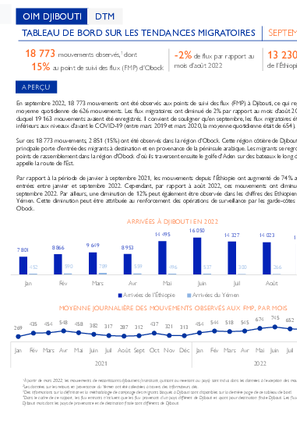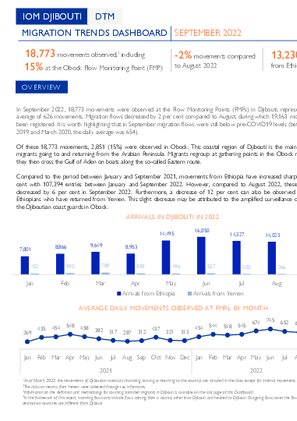-
Countries
-
Data and Analysis
-
Special Focus
-
Crisis Responses
The Russian invasion of Ukraine has forced an unprecedented number of people to flee their homes in search of safety.
This report brings together the results of desk research and survey projects carried out by the European Union Agency for Asylum (EUAA), the International Organization for Migration (IOM) and the Organisation for Economic Co-operation and Development (OECD) to detail forced displacement from and within Ukraine. It aims at providing practitioners and policy makers with a situational picture based on the perspective of the affected populations, themselves.

Contact
DTM Djibouti, DTMDjibouti@iom.int
Language
French
Location
Djibouti
Period Covered
Sep 01 2022
Sep 30 2022
Activity
- Flow Monitoring
En septembre 2022, 18 773 mouvements ont été observés aux points de suivi des flux (FMP) à Djibouti, ce qui représente une moyenne quotidienne de 626 mouvements. Les flux migratoires ont diminué de 2% par rapport au mois d'août 2022, au cours duquel 19 163 mouvements avaient été enregistrés. Il convient de souligner qu'en septembre, les flux migratoires étaient encore inférieurs aux niveaux d'avant le COVID-19 (entre mars 2019 et mars 2020, la moyenne quotidienne
était de 654).
Sur ces 18 773 mouvements, 2 851 (15%) ont été observés dans la région d’Obock. Cette région côtière de Djibouti est la principale porte d'entrée des migrants à destination et en provenance de la péninsule arabique. Les migrants se regroupent aux points de rassemblement dans la région d'Obock d’où ils traversent ensuite le golfe d'Aden sur des bateaux le long de ce qu'on appelle la route de l'Est.
Par rapport à la période de janvier à septembre 2021, les mouvements depuis l'Éthiopie ont augmenté de 74% avec 107 394 entrées entre janvier et septembre 2022. Cependant, par rapport à août 2022, ces mouvements ont diminué de 6% en septembre 2022. Par ailleurs, une diminution de 12% peut également être observée dans les chiffres des Ethiopiens revenus du Yémen. Cette diminution peut être attribuée au renforcement des opérations de surveillance par les garde-côtes djiboutiens à Obock.

Contact
DTM Djibouti, DTMDjibouti@iom.int
Language
English
Location
Djibouti
Period Covered
Sep 01 2022
Sep 30 2022
Activity
- Flow Monitoring
In September 2022, 18,773 movements were observed at the Flow Monitoring Points (FMPs) in Djibouti, representing a daily average of 626 movements. Migration flows decreased by 2 per cent compared to August, during which 19,163 movements had been registered. It is worth highlighting that in September migration flows were still below pre-COVID19 levels (between March 2019 and March 2020, the daily average was 654).
Of these 18,773 movements, 2,851 (15%) were observed in Obock. This coastal region of Djibouti is the main gateway for migrants going to and returning from the Arabian Peninsula. Migrants regroup at gathering points in the Obock region where they then cross the Gulf of Aden on boats along the so-called Eastern route.
Compared to the period between January and September 2021, movements from Ethiopia have increased sharply by 74 per cent with 107,394 entries between January and September 2022. However, compared to August 2022, these movements decreased by 6 per cent in September 2022. Furthermore, a decrease of 12 per cent can also be observed in figures of Ethiopians who have returned from Yemen. This slight decrease may be attributed to the amplified surveillance operations by
the Djiboutian coast guards in Obock.

Contact
DTM Burundi, DTMBurundi@iom.int
Language
French
Location
Burundi
Period Covered
Oct 24 2022
Oct 30 2022
Activity
- Mobility Tracking
- Event Tracking
La DTM Burundi a le plaisir de vous partager (dans le lien ci-dessus) des informations sur les urgences qui se sont produites au Burundi en dates du 24 au 30 octobre 2022. La DTM a identifié 1 483 personnes (742 ménages) affectées par la grêle, les pluies torrentielles et les vents violents dans les provinces de Cibitoke, Ruyigi, Rumonge et Muyinga.

Contact
DTM Support — iomdrcdtm@iom.int
Language
English
Location
Democratic Republic of the Congo
Period Covered
Oct 20 2022
Nov 06 2022
Activity
- Mobility Tracking
- Event Tracking
Depuis le 2 novembre 2022, on assiste à un retour progressif dans certaines localités des zones sous occupation du M23, notamment de l'axe Tongo et l'axe Ishasha-Nyamilima. Ces retours sont motivés, en plus de la diminution des affrontements qui ont provoqué une relative accalmie, par des campagnes de sensibilisation incitant la population déplacée à rentrer chez elle.
Ce rapport présente les données globales sur les déplacements de cette crise afin de renseigner sur la dynamique des mouvements pour mieux répondre aux besoins de planification humanitaire. Dans l’optique d’améliorer la compréhension globale de la crise, en informant, entre autres, sur les statistiques de déplacement et la sévérité des besoins multisectoriels des populations affectées ; les données de ce rapport sont complétées par des données d'évaluation en collaboration avec l’Intersos dans le Nyiragongo et le HCR (personnes déplacées vers l'Ouganda).

Contact
DTM Burundi, DTMBurundi@iom.int
Language
French
Location
Burundi
Period Covered
Oct 31 2022
Nov 06 2022
Activity
- Mobility Tracking
- Event Tracking
La DTM Burundi a le plaisir de vous partager (dans le lien ci-dessus) des informations sur les urgences qui se sont produites au Burundi en dates du 31 octobre au 6 novembre 2022. La DTM a identifié 2 126 personnes (876 ménages) affectées déplacées par les vents violents dans les provinces de Cibitoke et Rumonge.

Contact
DTMMozambique@iom.int
Language
English
Location
Mozambique
Period Covered
Oct 29 2022
Nov 07 2022
Activity
- Mobility Tracking
- Event Tracking
Fear of attacks and confirmed attacks by Non-State Armed Groups in Namuno district (Murameia community and Puararane) triggered 16,479 individual displacement movements from Hucula and Nicane locality to Namuno sede (Milipone locality). An estimate of 570 Internally Displaced Persons (IDPs) have been identified with vulnerabilities. Of the 16,479 individual displacement movements recorded, an estimate 782 households/ 3,531 Individuals (of which 1,987 represent children under 18 years), are being hosted in EPC Cumone (Milipone). All of the recorded movements represent individuals displaced for the first time.
IOM teams observed an average of 1,831 individuals arriving at different locations within the reporting period (29 October - 07 November, please see below for more information). Movements in the region continue to be dynamic among host communities.
The objective of the Emergency Tracking Tool (ETT) - Movement Alert is to collect information on large and sudden population movements, and to provide support to the humanitarian response partners by disseminating data on IDPs to support effective humanitarian response to the affected population. Information is collected through key informants interviews or direct observation. This dashboard provides basic information on displacements, and additional information can be shared upon request.
Contact
DTM Burundi, DTMBurundi@iom.int
Location
Burundi
Activity
- Mobility Tracking
- Event Tracking
Period Covered
Oct 31 2022 -Nov 06 2022
Activated on an ad hoc basis, the DTM Emergency Tracking provides early field reports at the beginning of a complex crisis, allowing IOM to gather, consolidate and disseminate baseline information on displacement and return figures at the onset of a newly emerging crisis. The DTM Emergency Tracking relies heavily on information provided by RARTs or partners within the humanitarian community about an unfolding situation. The Emergency Tracking gathers data through IOM Burundi’s extended network of key informants, who provide basic information on the new displacement, be it of IDPs or returnees, or both, including numbers, location and shelter types. While IOM DTM strives to provide best estimates, the Emergency Tracking aims to be a quick monitoring tool with real-time data turnover ranging from 24 to 72 hours following its activation.
Population Groups
Survey Methodology
Unit of Analysis Or Observation
Type of Survey or Assessment
Keywords
Geographical Scope
Administrative boundaries with available data
The current dataset covers the following administrative boundaries
Contact
DTM Burundi, DTMBurundi@iom.int
Location
Burundi
Activity
- Mobility Tracking
- Event Tracking
Period Covered
Oct 24 2022 -Oct 30 2022
Activated on an ad hoc basis, the DTM Emergency Tracking provides early field reports at the beginning of a complex crisis, allowing IOM to gather, consolidate and disseminate baseline information on displacement and return figures at the onset of a newly emerging crisis. The DTM Emergency Tracking relies heavily on information provided by RARTs or partners within the humanitarian community about an unfolding situation. The Emergency Tracking gathers data through IOM Burundi’s extended network of key informants, who provide basic information on the new displacement, be it of IDPs or returnees, or both, including numbers, location and shelter types. While IOM DTM strives to provide best estimates, the Emergency Tracking aims to be a quick monitoring tool with real-time data turnover ranging from 24 to 72 hours following its activation.
Population Groups
Survey Methodology
Unit of Analysis Or Observation
Type of Survey or Assessment
Keywords
Geographical Scope
Administrative boundaries with available data
The current dataset covers the following administrative boundaries

Contact
DTM Cameroon, DTMCameroon@iom.int
Language
French
Location
Cameroon
Period Covered
Aug 01 2022
Aug 31 2022
Activity
- Mobility Tracking
- Baseline Assessment
Depuis 2014, le Cameroun est l’objet d’attaques perpétrées par des groupes armés. Les attaques et les menaces récurrentes continuent de provoquer des déplacements de populations vivant dans la région de l’Extrême-Nord. Du fait de sa situation géographique et culturelle, et notamment sa proximité avec le Nigéria et le Tchad, la région a subi des dégâts matériels et humains importants.
En réponse, l’Organisation Internationale pour les Migrations (OIM) déploie, depuis novembre 2015, la Matrice de suivi des déplacements (Displacement Tracking Matrix- DTM, en anglais), un outil qui collecte des données sur les tendances de déplacement ainsi que les besoins humanitaires multisectoriels des personnes affectées par les crises. A travers sa composante du suivi des déplacements, la DTM collecte des données auprès d’informateurs clés (autorités locales, chefs de communautés, représentants de déplacés, gestionnaires de sites) au sein des localités et sites d’accueil des déplacés, retournés et réfugiés hors camp. Ces informations sont analysées et partagées avec la communauté humanitaire afin d’orienter les programmes de réponse ou des évaluations sectorielles plus approfondies.
Ce tableau de bord présente la situation de déplacement dans 1191 localités (1092) et site spontanés (99) accueillant les personnes déplacées internes (PDI), retournés et réfugiés hors camp. La collecte de données a été réalisée auprès de 4 298 informateurs clés entre le 11 et 24 août 2022 dans 6 départements de la région de l’Extrême-Nord : Diamaré, Logone-Et-Chari, Mayo-Danay, Mayo-Kani, Mayo Sava et Mayo-Tsanaga.

